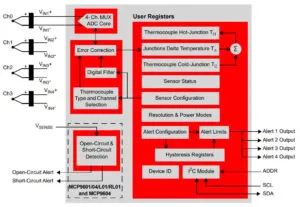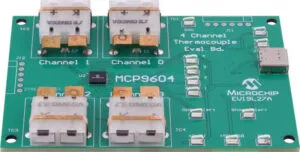
“MCP9604 delivers accuracy at four thermocouple locations by using higher-order NIST ITS-90 equations rather than the single-order linear approximations of analog amplifier designs,” according to the company. “As an example, it achieves ninth-order accuracy with K-type thermocouples, all in one integrated chip containing the ADCs, cold junction compensation temperature sensors, amplifiers and other components required for the signal chain, temperature measurement and math engine.”
±1.5°C is the worst case hot-junction accuracy with the IC in ambients between 0 to +85°C – the typical figure here is ±0.5°C, which is the same as the typical cold-junction accuracy.
Worst case across the full IC ambient range of -40 to +125°C is ±3°C for the hot junction and ±2°C for the cold junction. Typical resolution for both of the junctions is 0.0625°C.
All of the figures so far have been with a Vcc of 3.3V – the operating range is 2.7 to 5.5V.
Cold junction temperature is measured on the die, while the thermocouple materials will meet copper at the thermocouple connector on the PCB. To minimise errors, the connector needs to be adjacent to the IC and the data sheet suggests particular copper patterns for the PCB that extend from the IC’s thermal pad around the connector locations.
Control for the IC is over an I2C bus, and it can be set for any of these thermocouple types: K, J, T, N, S, E, B or R.
For example: K-types can sense across -200 to +1,372°C, or J-types across -150 to +1,200°C. B-types can work up to +1800°C.

EV19L27A is an evaluation board with connectors to accept four Type-K thermocouples – which have to be bought separately (Omega Engineering 5SRTC-TT-K-24-36 is suggested). To evaluate other thermocouple, the connectors have to be changed to suit.
Find Microchip’s MCP9604 web page here.
In June, Chell Instruments announced a 32 input precision thermocouple scanner inside a huge copper block for cold-junction management.






